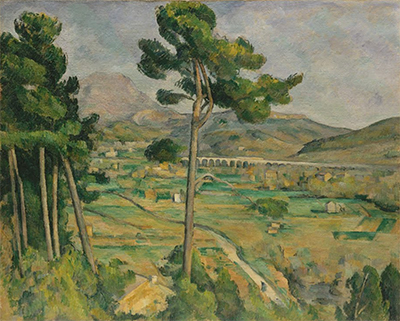Mont Sainte-Victoire and the Viaduct of the Arc River Valley, executed between the years 1882 and 1885, is an oil-on-canvas painting by Paul Cezanne that depicts a rural landscape in Southern France.
The French artist, visiting his sister's property that was situated near the town of Aix-en-Provence, prepared the preliminary works for the painting on a hill that was adjacent to his sibling's house and which overlooked the river valley as well as the mountain that towered above it. A viaduct, resembling the Roman aqueducts that were built in Gaul over a thousand years before the first railways were constructed in France, crosses over the distant river.
The painting, measuring 65.4 cm by 81.6 cm and on display at the Metropolitan Museum of Art in New York City, was created during the mature period of Cezanne's career that lasted from 1878 until 1890. Paris, in which the French artist had spent most of his adult life and which had served as the inspiration for so many of his earlier paintings, was abandoned for the rural landscapes and Mediterranean climate of Provence and this change in scenery would mark the beginning of a new artistic direction. The decision to paint the Arc river valley, in which the outskirts of Cezanne’s hometown can be seen in the distance, enabled him to reconnect with the land of his birth.
Six trees, positioned on the left-hand side of the canvas, dominate the foreground of the painting and partially obscure the view of the river valley below. A shock of foliage, created in different shades and hues of green by small flicks of the French painter’s brush, crowns the tops of the long and bare tree trunks. The gable roof of a house in the valley below, with a small chimney positioned at its apex, can be seen through a gap in the trees. Green fields, divided by hedges and dotted with the occasional farmhouse, meet the outskirts of the town on the right-hand side of the painting where the shapes of buildings emerge from the blurred mass at the foot of the mountains.
The arrival of the railways in Aix-en-Provence, connecting the provincial city with the capital and branching out to Marseille, revolutionised transport in the rural South of France and forever changed the landscape. This work of modern engineering, in which the wonders of the industrial world were brought to the countryside, forever changed the popular conception of rural landscapes and heralded the dawn of a new age. The viaduct, allowing trains to carry passengers through the river valley, represents the bridge between provincial France and the capital.




